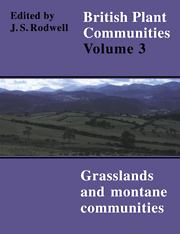Book contents
- Frontmatter
- Contents
- List of Figures
- Preface and Acknowledgements
- Preamble
- Mesotrophic Grasslands
- Community Descriptions
- Calcicolous Grasslands
- Community Descriptions
- Calcifugous Grasslands and Montane Communities
- Community Descriptions
- Index of Synonyms to Grasslands and Montane Communities
- Index of Species in Grasslands and Montane Communities
- Bibliography
MG8 - Cynosurus Cristatus-Caltha Palustris Grassland
Published online by Cambridge University Press: 04 July 2020
- Frontmatter
- Contents
- List of Figures
- Preface and Acknowledgements
- Preamble
- Mesotrophic Grasslands
- Community Descriptions
- Calcicolous Grasslands
- Community Descriptions
- Calcifugous Grasslands and Montane Communities
- Community Descriptions
- Index of Synonyms to Grasslands and Montane Communities
- Index of Species in Grasslands and Montane Communities
- Bibliography
Summary
Synonymy
Water meadows Fream 1888a, Duffey et al. 1974, Ratcliffe 1977, all p.p.; Senecioni-Brome turn racemosi R.Tx. & Preising 1951.
Constant species
Anthoxanthum odoratum, Caltha palustris, Cerastium fontanum, Cynosurus cristatus, Festuca rubra, Holcus lanatus, Leontodon autumnalis, Poa trivialis, Ranunculus acris, Rumex acetosa, Trifolium repens.
Physiognomy
The Cynosurus-Caltha community is a species-rich and varied grassland with no single species consistently dominant. Grasses generally account for most of the cover and all five of the constant species may be abundant. A variety of other grasses may be present but these are much less frequent and only occasionally prominent: Festuca pratensis, Lolium perenne, Agrostis stolonifera, A. capillaris, Dactylis glomerata and Briza media. There are almost always some sedges in the sward, although some of these are smaller species with far-creeping rhizomes and easily under-estimated in sampling. Carex panicea and C. disticha are the most frequent and abundant with occasional records for C.flacca, C. nigra, C. demissa, C. ovalis and C. hirta. Junci are uncommon in this vegetation and never dominate.
Dicotyledons are generally well represented and certain species are sometimes sufficiently abundant to give a distinctive stamp to the physiognomy. Notable among these are Caltha palustris which is unpalatable to stock and whose large leaves are often prominent in the sward and Filipendula ulmaria which, when flowering, may protrude above the other herbage. Ranunculus acris, R. repens, Trifolium repens and T. pratense are frequent and sometimes abundant with usually smaller amounts of Leontodon autumnalis, Cerastium fontanum, Bellis perennis and Plantago lanceolata. Among the occasional are species characteristic of relatively unimproved meadows (e.g. Sanguisorba officinalis, Lathyrus pratensis, Leucanthemum vulgare, Centaurea nigra, Alchemilla glabra and A. xanthochlora) and a wide range of poor-fen species (e.g. Cardamine pratensis, Achillea ptarmica, Lotus uliginosus, Lychnis flos-cuculi, Angelica sylvestris, Valeriana dioica, Galium palustre and G. uliginosum). Other notable species at low frequency are Geum rivale, Senecio aquaticus, Myosotis scorpioides and, to the north and west, Crépis paludosa and Trollius europaeus. Although not recorded in the sampling, the rather local Bromus racemosus occurs in this community.
Bryophytes are somewhat patchy but Calliergon cuspidatum may be conspicuous with, less frequently, Brachythecium rutabulum, Eurhynchium praelongum and Plagiomnium rostratum.
- Type
- Chapter
- Information
- British Plant Communities , pp. 79 - 81Publisher: Cambridge University PressPrint publication year: 1992

